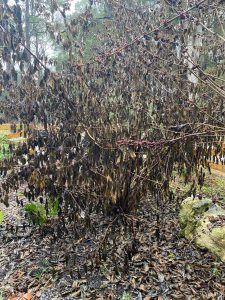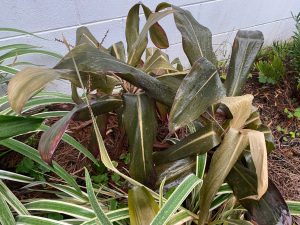First, don’t panic. Second, do NOTHING right now. Yes there is a lot of brown, wilted, soggy leaves, and stems. It’s natural for us to react by getting out there and start to cut out the brown and even removing what you “think’ is dead.
 Take deep breath and keep Taylor Swift’s song, “Shake it Off” in back of your mind every time you have that urge to cut something back. Look the other way until early to mid-March.
Take deep breath and keep Taylor Swift’s song, “Shake it Off” in back of your mind every time you have that urge to cut something back. Look the other way until early to mid-March.
Plants-ANY pruning right now encourages cells to start producing new growth, whether it be buds, or new leaves or even little nodes. Another frost or freeze will damage this new growth and stresses out that plant that much more. It will set it back and become weaker thus opening itself up for other problems like rot, diseases and other pest that take advantage of weak/stressed plants. In our area we will have another cold spell before March, so it’s not worth taking the change and your plants will be better off for the wait. No fertilizing or pruning.
Turfgrass may be injured. Especially with the 20 degrees Fahrenheit, we saw (4) nights in a row last week. The grass may initially appear wilted, and then turn a whiteish or brown color. If your lawn does not recover in the spring, you can easily replace the areas with sprigs or plugs, or maybe that area that didn’t make it, a new flower bed or vegetable bed may just be the answer for that spot. Mother Nature has a way of helping us make changes that we otherwise wouldn’t. No fertilizing or mowing until spring when we can better inspect closer.
Do ch eck for water needs. We had a lot of dry air during the freezing temperatures the plants worked overtime transpiring, so water to rehydrate. The dead foliage looks bad but does help insulate plants from further injury. In the spring, assess the extent of the damage by scraping the bark with your fingernail. Cold-injured wood will be black or brown under the bark. To be certain where to prune, wait until plants begin to sprout new growth.
eck for water needs. We had a lot of dry air during the freezing temperatures the plants worked overtime transpiring, so water to rehydrate. The dead foliage looks bad but does help insulate plants from further injury. In the spring, assess the extent of the damage by scraping the bark with your fingernail. Cold-injured wood will be black or brown under the bark. To be certain where to prune, wait until plants begin to sprout new growth.
“Shake it off” and wait till spring. https://gardeningsolutions.ifas.ufl.edu/lawns/lawn-care/how-to-help-your-lawn-survive-the-chill.html or contact UF/IFAS Taylor County Extension office at 850-838-3508, Lisa Strange, Agriculture and Natural Resources Agent.
Source: UF/IFAS Pest Alert
Note: All images and contents are the property of UF/IFAS.



